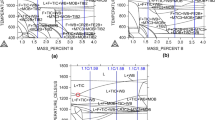Conclusions
In selecting a treatment schedule providing uniform distribution of carbides in cast hypoeutectic steels for rolls it is necessary to take account of the fact that the cementite network along grain boundaries dissolves in the temperature range 850–950°C. In steel with a low content of carbide-forming elements eutectic cementite does not dissolve at these temperatures. As the heating temperature is increased from 850 to 1100°C intense surface graphitizing commences, which points to the possibility of forming graphite inclusions with bulk heat treatment. With an increase in the content of chromium and molybdenum in steel the graphitizing process is suppressed, and carbon is bonded into stable carbides. In such a steel eutectic carbides dissolve at 1050–1100°C. Preparation of a structure with uniform carbide distribution during heat treatment is only possible in steels containing about 2% Cr and not less than 0.3% Mo.
Similar content being viewed by others
Additional information
Ukrainian Research Institute of Metallurgy. Translated from Metallovedenie i Termicheskaya Obrabotka Metallov, No. 8, pp. 62–64, August, 1987.
Rights and permissions
About this article
Cite this article
Mikhailova, I.V., Rudyuk, S.I. & Savon, A.I. Effect of alloying elements on the structure of cast hypereutectoid steels after heat treatment. Met Sci Heat Treat 29, 634–637 (1987). https://doi.org/10.1007/BF00763123
Issue Date:
DOI: https://doi.org/10.1007/BF00763123




